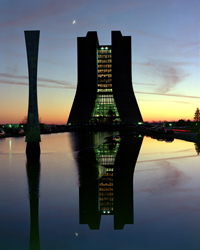|
||
      |
Chicago lands Fermilab contract
On November 1 the U.S. Department of Energy selected Fermi Research Alliance, LLC, to operate Fermi National Accelerator Laboratory, effective January 1. The research alliance is the second University-formed corporation in four months to receive a DOE contract to operate a national laboratory. Last July the University, through UChicago Argonne, LLC, won its bid to continue managing Argonne National Laboratory.

Fermilab leaders expect the lab to remain a force on the particle-physics
horizon.
A partnership between Chicago and Universities Research Association, Inc., FRA was formed to enter the Energy Department’s Fermilab-management competition and is dedicated to running the laboratory. The URA—a nonprofit consortium of 90 research-oriented universities, including Chicago, founded in 1965 to operate research facilities in the national interest—has operated Fermilab since its 1967 inception. Both Fermilab and Argonne belong to the DOE, whose Office of Science is the nation’s largest supporter of federally funded research in particle physics.
“The science of particle physics has never been more exciting,” said Piermaria Oddone, Fermilab director and FRA president. “Discoveries are ahead that will revolutionize our picture of the universe. A strong and well-managed Fermilab will be key to maintaining U.S. leadership in particle physics.” The research alliance, Oddone noted, hopes to bring to Illinois the International Linear Collider (ILC), a proposed particle accelerator that would allow physicists to explore phenomena beyond the reach of today’s accelerators.
Scientists expect that the ILC, in partnership with the Large Hadron Collider under construction in a tunnel across the Swiss-French border, would radically change scientific understanding of the universe. While laying the groundwork for the ILC, Fermilab scientists will continue to use the Tevatron—the world’s most powerful particle accelerator—and to study neutrinos, subatomic particles with no electric charge and miniscule mass. In astrophysics, a third major area for Fermilab research, scientists will study the connections between the inner space of subatomic particles and the outer space of cosmology.
Chicago faculty members and graduate students have been involved in Fermilab research since the lab’s beginnings, helping design and build the first detector (the Collider Detector) for proton-antiproton collisions, leading major experiments, and initiating the astrophysics program and Argentina’s Pierre Auger Cosmic Ray Observatory. Fermilab has 1,900 employees at its 6,800-acre site near Batavia, Illinois, about 30 miles west of Chicago. Some 3,000 scientists from 260 universities and laboratories in 37 states and 31 countries collaborate in Fermilab research.
“The University of Chicago’s role in managing both Argonne and Fermilab,” said University President Robert J. Zimmer, who chairs the FRA board of directors, “will pre--sent opportunities for important new synergies between the two laboratories.” A new Laboratory Collaboration Council, led by the directors of Fermilab and Argonne, will explore common interests in accelerator science, management, and technology transfer.